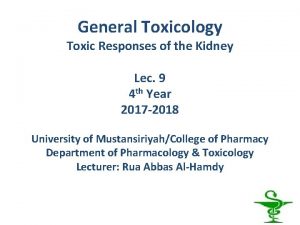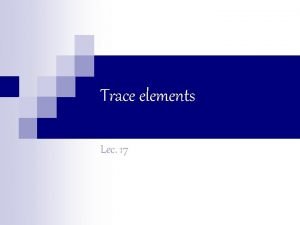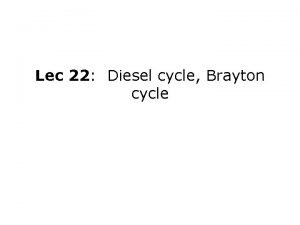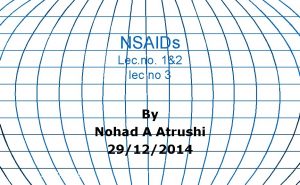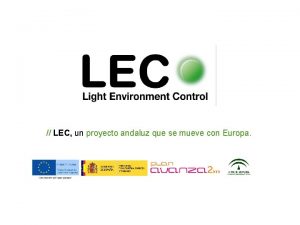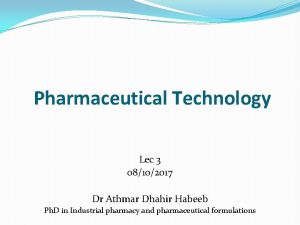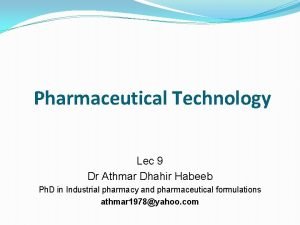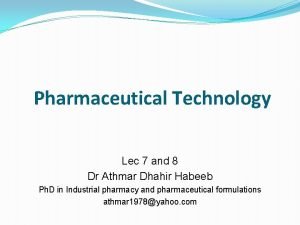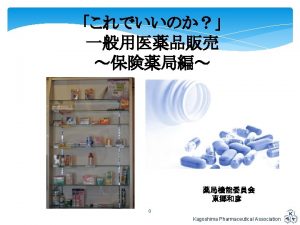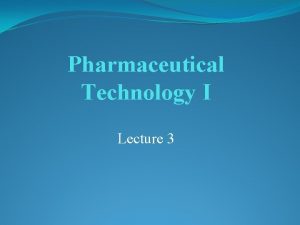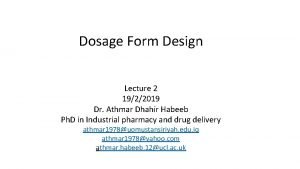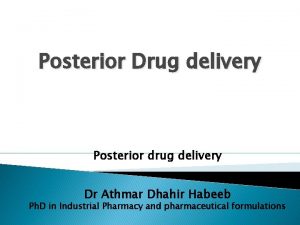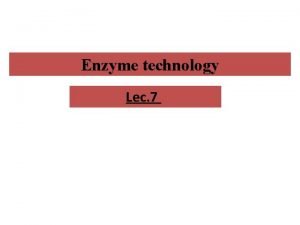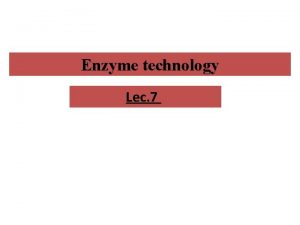Pharmaceutical Technology Lec 1 2 03102017 Dr Athmar


















- Slides: 18

Pharmaceutical Technology Lec 1 -2 03/10/2017 Dr Athmar Dhahir Habeeb Ph. D in Industrial pharmacy and pharmaceutical formulations

In this course the following subjects will be covered �Dispersed systems , their classification �Solutions and types of solutions �Solubility, factors affecting solubility, preparation of solutions containing non-volatile materials �Official solutions, their classification, preparation and uses �Aqueous solutions containing aromatic waters �Syrups � Definition and methods of clarification, filter aids �Spirits and elixirs �Extraction, maceration and percolation �Tinctures, fluid extracts �Colloidal systems, suspension

Dispersed systems �Dispersion (dispersed system) is a mixtures of two substances, one of which (dispersed phase) is distributed in form of subdivided particles throughout another substance (dispersion medium). �Classification of dispersed systems Molecular dispersions �Molecular dispersion is a true solutions. The dispersed phase (solute) is in form of separate molecules homogeneously distributed throughout the dispersion medium(solvent). The molecule size is less than 1 nm. Example of molecular dispersions is aqueous solutions of salts. Colloids �Colloids are micro-heterogeneous dispersed systems, in which the size of the dispersed phase particles is within the range 1 - 1000 nm. The colloids phases can not be separated under gravity, centrifugal or other forces. Dispersed phase of colloids may be separated from the dispersion medium by micro-filtration. Example is emulsions.

Coarse dispersions �Coarse dispersions are heterogeneous dispersed systems, in which the dispersed phase particles are larger than 1000 nm. Example suspensions.

Solutions Solution: One phase system of two or more substances that are homogenously mixed (true solutions). This system may be: Solid Liquid (the pharmacist most frequently used ) Gas �Liquid solution: The solvent is liquid while the solute may be liquid, solid or gas.

Types of solutions: 1 - Solution of liquid in liquid �When two liquids such as water/alcohol are mixed a homogenous system is formed irrespective of the proportions (miscible) �When phenol /water are mixed a homogenous system only formed when mixed in a certain proportion (miscible in certain proportion). When mineral /water are mixed no system is formed when mixed at any proportion (immiscible). 2 - Solution of solid in liquid �Most of true solutions are example of solid in liquid solution.

3 - Solution of gas in liquid �The solubility of gas in liquid is described by Henry, s Law which state that the solubility of gas is very nearly proportional to the pressure if the temperature remain constant provided that the gas is only slightly soluble. Effect of temperature on solubility of gas: � Increase the temperature lead to decrease the solubility, e. g CO 2 is twice as soluble 0 o. C as it at 20 o. C. Note: When a salt is added to a liquid containing dissolved gas, liberation of gas occurs due to the decrease solubility (salting out of the gas).

Solubility �The solubility of an agent in a particular solvent indicates the maximum concentration to which a solution may be prepared with that agent and that solvent (solubility) �When excess of solid (solute) is shaken with liquid (solvent) for a period of time a maximum amount of it will be dissolved (saturated solubility). � When excess amount of solute is added to saturated solution and the temperature is increased more of solute will be dissolved (super saturated solution).

Factors affecting solubility: �Tempreture: Solids are usually more soluble in hot than in cold water. In the process of solution we have three cases: 1. Endothermic reaction: Increase in the temperature lead to increase solubility. 2. Exothermic reaction: Increase in the temperature result in decrease solubility. 3. When heat is neither absorbed nor given off in the process of solution: Increase or decrease in the temperature results in no effect on the solubility.

Solubility against rate of solution: �A distinction should be made between degree of solubility and rate of solution, �Rate of dissolution is the speed at which the solute goes into solution Rate of solution = ΔC/Δt = mg/ml/min. Rate of dissolution depends on: Particle size of solute: Reduction in particle size results in increase S. A. and increase rate of solution. Agitation: Increase agitation result in increase rate of solution by removing the more concentrated solution from the surface of solute and bringing in less concentrated solvent. Heating: Results in increase solubility by increase the frequency with which solvent molecule collides with the surface of dissolving material.

Factors affecting solubility Effect of molecular structure : �The more nearly solute and solvent are alike molecular structure the greater the solubility of one in the other. �Water is composed of covalent molecules which are described as polar structures with strong dipole characteristics (negative and positive regions). Polar solvents like water will dissolve salts and other electrolyte readily so they are poor solvents for non polar substances.

�Polar liquids may act as solvent when it and solute are capable of complexation by H-bound formation e. g. water and alcohol of low M. wt. As the M wt of alcohol increased resulted in decrease polarity and decrease the solubility in water.

�Carbon tetrachloride (CCl 4 ) is non polar. Non polar liquids don’t dissolve polar or slightly polar substance. �Ethyl alcohol molecule Have: � 5 non polar carbon –Hydrogen bond � 1 C-C bond (non polar) �C-O bond & H-O bond (polar) So it is considered as good solvent for some polar and non polar substances due to the presence of distinct polar and non polar regions.

General notes �The more nearly solvents and solutes are alike structurally, the more rapidly solution takes place. �Polar liquids dissolve electrovalent compounds readily, but they are poor solvents for non polar substances. On other hand , non polar liquids are required for non polar solutes. �Complex organic compounds which have polar and non polar groups in their molecules may dissolve in polar liquids. �Semipolar liquids , such as ethyl alcohol process some of properties of both polar and nonpolar solvents.

Effect of p. H on solubility �Organic substances are either weak acids or weak bases. Their aqueous solubility depends on p. H of solvent. �The solubility in water of weak organic acids such as barbiturates & sulfonamides is increased as the p. H increased by addition of base. This increase in solubility is due to the formation of water soluble salts. So: �If the p. H of Phenobarbital solution is increased above 5. 5 by addition of strong base the solubility will increase. �If the p. H of Phenobarbital solution is decrease by addition of strong acid Phenobarbital (free acid) will precipitate.

�The solubility in water of weak organic base (alkaloids) increase as the p. H decrease by addition of acid due to the formation of water soluble salts �If the p. H of aqueous solution of salt is increased by addition of base atropine (free base will be precipitate).

�At a given p. H the degree of ionization weakly acid or basic drug depends on its pka value which is the –ve Log of its dissociation constant. For weak acidic drugs: S - So p. H = p. Ka +Log ------- So S = molar concentration of drug (dissociated and undissociated) species in solution. So=molar solubility of undissociated species. �This equation derived from Handerson –Hasselbach equation. For weak basic drug: So p. H= p. Kw – p. Kb + log ------- S - So �Note: These equations may be used to calculate the p. H at which a weak acids or bases will precipitate from solution of its salt.

�Importance of p. H on absorption and excretion: �The unionized form can pass the biological membrane due to its lipid solubility and since the membrane is lipoprotein in nature. The ionized form can also pass the biological membrane by carrier mediated mechanism. �If toxic acidic substance is taken by patient, we give him basic compound to change it to ionized form that are more soluble and cannot be reabsorbed by kidney tubules and will be excreted by kidney out of body, and vice versa if we have basic compound.






